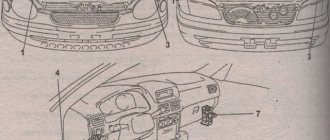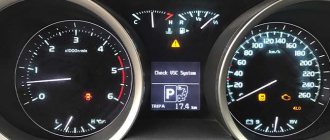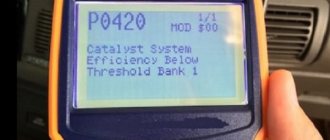What to do if your car has symptoms of a “dead” air flow sensor? Before going to a service station or store for a new expensive sensor, try checking it yourself.
The mass air flow sensor (MAF or MAF-sensor) controls the volume of incoming air into the intake system of the internal combustion engine to create a fuel-air combustible mixture. This allows you to get maximum engine power with minimal fuel consumption. The correct operation of all other interconnected engine systems depends on the readings of the mass air flow sensor.
The principle of operation of the mass air flow sensor
Most mass air flow sensors have two highly sensitive heating filaments (thermistors). The filaments are made of platinum or tungsten, and an electric current is applied to them to heat them to a certain temperature.
One sensor thread is located directly in the air line, and the second is protected by a special screen from direct air flow. When the engine is running, the air flow passing through the sensor cools the exposed filament more. As a result, a temperature difference arises between the thermistors, and an open thread requires more current to restore the required temperature.
Taking into account the cooling intensity of the thermistor and the difference in readings between the threads, the electronic control unit (ECU) calculates the amount of air entering the intake tract and determines the required amount of fuel for stable engine operation. Many mass air flow sensors additionally have a built-in air temperature sensor entering the intake tract, which allows you to take more accurate readings.
Some MAF sensors use either a sputtered ceramic heating element or a semiconductor film instead of highly sensitive filaments. But the principle of operation of the sensor remains the same.
Where is the MAF located?
The mass air flow sensor is located in the vehicle's intake tract, between the air filter and the throttle valve, and is mounted directly on the air filter housing.
DESCRIPTION
The MAF sensor (mass air flow sensor) measures the volume of air passing through the throttle body. The ECM uses this information to determine the duration of fuel injection and generate the appropriate air-fuel ratio. Inside the MAF sensor there is a heated platinum wire that is exposed to the incoming air flow. By passing a specified amount of current through the wire, the ECM heats it to the desired temperature. The flow of incoming air cools the wire and the internal thermistor, changing their resistance. To keep the current constant, the ECM varies the voltage applied to specified devices in the MAF sensor. The voltage level appears to be proportional to the air flow rate passing through the sensor, and the ECM uses this level to calculate the intake air volume. This circuit is designed in such a way that the heated platinum wire and the temperature sensor form a bridge circuit, and the power transistor is controlled so that the potentials of A and B remain unchanged, thereby maintaining the set temperature.
- Open or short circuit in the mass air flow sensor circuit
- Mass air flow sensor
- ECM
- Open or short circuit in the mass air flow sensor circuit
- Mass air flow sensor
- ECM
- Open or short circuit in the mass air flow sensor circuit
- Mass air flow sensor
- ECM
Symptoms of a faulty air flow sensor
If the mass air flow sensor begins to produce incorrect data, then a failure occurs in the system for preparing the fuel-air mixture, and the proportions of fuel and air are disrupted. This results in the following symptoms of a malfunction:
- Unstable idle speed
- Violation of the smooth running of the car
- Difficulty or impossible to start the engine
- Noticeable deterioration in vehicle dynamics
- Increased fuel consumption
- The yellow "Check Engine" light on the instrument panel does not go out
Check engine light on the instrument panel
If the Check Engine light is constantly on on the instrument panel, the easiest way to check, if you have a diagnostic tool, is to read the error codes, which will allow you to pinpoint the problem. One of the most common DMRV errors is error p0100. Explanations of diagnostic codes can be found in the technical literature for a specific vehicle.
None of the above symptoms are a 100% guarantee that the mass air flow sensor has failed. Other vehicle systems may also be to blame. But all these symptoms together, or each one separately, give reason to check the flow meter for performance.
Error 42
Quite often, Toyota car owners have problems with the speedometer. When diagnosing a car, error code 42 appears. Error 42 on a Toyota car is a signal of a malfunction of the speed sensor. The speed sensor performs one of the main functions of the car. It converts the rotational speed of the drive shaft into the frequency of electrical impulses, which are proportional to the speed of the vehicle, and also converts the number of revolutions of the drive shaft into electrical impulses corresponding to the distance traveled by the vehicle. The speed sensor monitors fuel consumption and transmission control; it is mounted on the transmission housing.
How to determine a faulty air flow sensor
The easiest way to check the functionality of the air flow sensor is to disconnect it from the system. As a rule, this method shows almost 100% whether the element is working or not.
First you need to start the car and warm up the engine a little by accelerating. After about 3 minutes, turn off the engine and remove the sensor terminal. We return to the salon and start the car again. If the speed increases noticeably, then the mass air flow sensor is faulty.
Also, having removed the sensor, you will notice a faster increase in speed when accelerating with the pedal than was the case with the sensor. If the mass air flow sensor is not replaced in time, the fuel mixture will be too rich, which will lead to oil dilution and engine overheating.
Manifestation of error 42
Error code 42 in Toyota cars often causes disappointment among owners, since such an error is quite rare. If the speed sensor is faulty, when you turn on D in automatic transmissions, the box turns off after a few seconds, and the engine speed increases sharply due to the fuel supply. The automatic transmission does not engage gears, only reverse gear R works.
In manual transmissions, the operation of the car is also disrupted. When the car is moving, the speedometer does not work and the engine does not run smoothly.
How to check the air flow sensor (3 ways to check)
In some cases, to check the mass air flow sensor, it must be removed from the car. Dismantling procedure:
- Loosen the clamp
- Remove the air pipe,
- Unscrew the screws securing the sensor to the air filter housing.
- Before disconnecting the electrical connector, you must remove the negative terminal from the battery. This must be done so that the electronic engine control unit does not generate an error and the check lamp does not light up.
Method number 1. Visual control
To do this, you need to remove the sensor and carefully inspect it for mechanical damage or foreign objects or debris. It is also worth visually assessing the integrity of the heating filament sensors or heating film.
Such problems can arise due to a leaky air filter housing, or due to a poor-quality air filter.
If visible damage is detected, the sensor must be replaced. And if there is debris or dirt in it, the air flow sensor can be cleaned with special products or a carburetor cleaner (alcohol-based spray). Mass air flow sensors are very fragile, so be careful not to clean them mechanically. The sensor cannot be repaired!
Method number 2. Power off
The easiest way to check the mass air flow sensor is to disconnect power from it. With the engine not running, disconnect the electrical connector on the mass air flow sensor. Then we start the engine.
In this situation, the engine control unit switches to backup mode and replaces the readings of the disabled sensor with those programmed by the manufacturer.
In this case, engine operation should normalize and idle speed should increase. For additional checking, you can drive a car with the MAF connector disconnected - 100-200 meters. If all symptoms of a malfunction of the mass air flow sensor have disappeared, then the sensor is transmitting incorrect data - it is considered inoperative and requires replacement.
When checking the mass air flow sensor in this way, after disconnecting the electrical connector from the sensor, the “Check” engine error lamp will light up on the instrument panel. After completing the check or replacing it, you will need to reset the error! To do this, you can disconnect the negative terminal of the battery for a few minutes (carefully, absolutely all settings will be lost). In some car models, the error can only be reset at a service center using a special scanner connected to the car’s diagnostic connector.
Method number 3. Checking with a multimeter
To check the air flow sensor with a multimeter, you need to know which parameters to measure and from which contacts of the electrical connector. They may differ for each car brand. The location of the sensor wires and terminals can be found in the vehicle's electrical diagram.
For example, on Bosch sensors that are installed on VAZ and GAZ cars, you can check the voltage (V) between the incoming signal and ground at the mass air flow sensor connector. To do this you need:
- Turn on the car ignition, but do not start the engine,
- Connect the red (+) probe of the multimeter to the yellow wire,
- The black (-) probe goes to the green wire of the connector.
- We set the mode switch on the multimeter to measure the minimum direct current.
The voltage at the contacts should be between 1.00-1.04 Volts . If the readings are higher, the sensor requires replacement.
Additionally, you can remove the sensor without disconnecting the electrical connector and apply a stream of air to the sensor from the air filter side. The voltage should increase to 1.3 Volts , in which case the air flow sensor is considered working.
Depending on the sensor design, it is still possible to measure the resistance on the resistors. Moreover, the measurement results at different air temperatures will be different. Accurate data on the optimal values of resistance readings, measurement temperatures and the location of contacts on the connector are usually indicated either in special technical literature or in the car repair instructions.
Checking and repairing at home
There are eight ways to independently check amplitude and frequency mass flow sensors.
The method consists of disconnecting the sensor from the fuel system of the car and checking the functionality of the system without it. To do this, you need to disconnect the device from the connector and start the engine. Without a mass air flow sensor, the controller receives a signal to switch to emergency operation mode. It prepares the air-fuel mixture only based on the throttle position. If the car moves faster and does not stall, it means that the device is faulty and requires repair or replacement.
If the standard firmware has been changed, then it is unknown what reaction of the controller is programmed in it in case of an emergency. In this case, you should try to insert a 1mm thick plate under the throttle stop. The turnover should increase. Now you need to pull out the chip from the air flow meter. If the power unit continues to work, then the cause of the malfunction is the firmware.
Install a known good part and start the engine. If after replacement it begins to work better, the motor does not stall, then replacement or repair of the device is required.
To do this, use a Phillips screwdriver to unscrew the clamp holding the air collector corrugation. Then you need to disconnect the corrugation and inspect the internal surfaces of the air collector corrugation and the sensor.
There should be no traces of oil or condensation on them, the surfaces should be dry and clean. If you do not take care of the air filter and change it rarely, then dirt can get on the sensitive element of the sensor and cause it to break. This is the most common malfunction. Traces of oil may appear in the flow meter if the oil level in the crankcase is high, or if the oil sump of the crankcase ventilation system is clogged. If necessary, you need to clean the surfaces using special cleaning products.
To do this, you need to turn on the tester in a mode in which constant voltage is checked. The limit value for measurements should be set to 2V.
- The yellow wire is located closer to the windshield. It serves as an input for a signal from the flow meter.
- The white-gray wire is the sensor voltage output.
- The black and pink wire leads to the main relay.
- The green wire is used to ground the sensors, that is, it goes to ground.
The wires may have different colors, but their location is unchanged. To check, you need to turn on the ignition, but do not start the car. The red probe from the multimeter must be connected to the yellow wire, and the black one must be connected to ground, that is, to the green wire. We measure the voltage between these two outputs. Multimeter probes make it possible to connect without disturbing the insulation of the wires.
On the new device, the output voltage ranges from 0.996 to 1.01 V.
During operation, this voltage gradually increases and by its value one can judge the wear of the flow meter:
- if the sensor is in good condition, the voltage is from 1.01 to 1.02 V;
- in satisfactory condition - from 1.02 to 1.03 V;
- the sensor resource ends if the voltage is in the range from 1.03 to 1.04 V;
- a value in the range from 1.04 to 1.05 indicates a near-death state; if there are no contraindications, then you can continue to use the sensor;
- if the voltage exceeds 1.05 V, the mass air flow sensor requires replacement.
Diagnostics of the mass air flow sensor "Tseshkoy" is not difficult and can be done with your own hands.
If there is dirt on the removed sensor, you can clean it yourself. You can use WD-40 to wash it. To clean the mass air flow sensor, you must first remove the pipe from it, and then dismantle the device itself. Inside the device there is a mesh and several wires - sensors.
Flushing the sensor will help avoid costly repairs.
- Install a diagnostic program on your phone (smartphone), tablet or laptop computer (for example, Torque Pro, Opendiag, BMWhat, OBD Auto Doctor).
- Connect your mobile device or laptop to the diagnostic connector located on the vehicle's electronic control unit using a special cable, Bluetooth channel.
- Launch the diagnostic utility on your phone (smartphone) or computer.
- Wait until the program finishes scanning all vehicle components. As a result, the utility will check the serviceability of each vehicle unit.
- Decipher the error codes that the program will show after the diagnostics are completed.
To perform this method, testers are used:
- K-Line 409/1;
- Scanmatic;
- ELM (ELM) 327;
- OP-COM.
To identify a malfunction of the mass air flow sensor without removing it from the car, you need to:
- Install a program called “VASYA diagnostician” on your laptop (laptop) and run it.
- Connect the adapter to the vehicle's diagnostic port.
- Select the item “Electronics 1” or “01 – Engine electronics” from the “Control unit” tabs to connect to the vehicle’s control unit.
- Go to “Custom Groups”.
- Select 211, 212 (passport value) and 213 (current value).
- Compare current indicators with passport data. If the deviations are high, then it is necessary to replace the mass air flow sensor.
This method is used to test frequency-type flowmeters.
To check the mass air flow sensor with a motor tester (oscilloscope), you need to connect it to the sensor (depending on the car brand) and start the engine.
Mass air flow sensor check parameters:
- transient time when the ignition is on;
- air consumption readings at idle and a sharp increase in engine speed;
- voltage in the sensor network.
The output data is individual for different types of engines. Before diagnosis, you should check the current indications with an official representative.
If all else fails, buy a new air flow sensor
All testing methods showed the same result - “Sensor to be replaced.” The mass air flow sensor is quite expensive, and you should approach its purchase consciously.
Using the example of the same manufacturer Bosch for LADA and GAZ (article 0280218037) - according to the search results on the GisAuto portal as of September 18, 2021, 568 offers from different cities were found in Russia. The cost of this sensor varies from 2,490 rubles. up to 6,676 rub. Such a range in prices may depend on various reasons: availability, delivery time, purchase cost, etc.
You can select a mass air flow sensor for your car on the GisAuto portal - you can use the part number, make and model of your car, and also create a request using the VIN number of the car, and then the sellers themselves will send you their offers. All you have to do is choose the option that suits the price and time frame.
Replacement procedure
If error 42 appears, it is necessary to check the speed sensor and control unit only at a specialized car service center. If it malfunctions, it must be replaced or cleaned.
The replacement procedure is very simple and does not require effort:
- It is necessary to remove the battery, as it may interfere with replacement.
- We remove the plastic tray that covers the sensor itself and limits access to it. There is no need to remove the control unit! Inspect for oil leaks in the O-ring area.
- We remove the chip so as not to damage it during further dismantling.
- We visually find a large screw that secures the sensor itself. Before dismantling, it is necessary to apply WD-40 to the screw so as not to damage it in the future. After unscrewing the screw, remove the O-ring and put a new one in its place. Next, the sensor does not hold anything, we carefully pull it up. We remove it carefully so that the surface of the device and the sealing ring are not scratched. Before installation, it is necessary to lubricate the seating area of the new O-ring and sensor with oil to avoid damaging them. We move the shaft and gear into the new sensor and assemble it in the reverse order.










